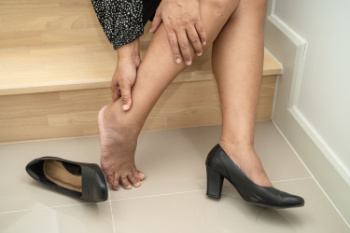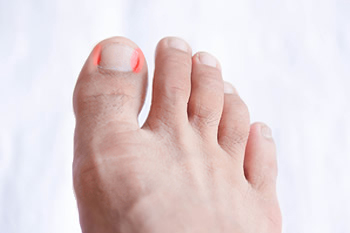
Hammertoe and mallet toe are common toe deformities, but they affect different joints. Hammertoe typically involves the second toe and bends at the middle joint, causing it to curl downward. Mallet toe, on the other hand, affects the joint closest to the toenail, making the tip of the toe point down. Both conditions often develop from pressure caused by wearing tight shoes, injury, or muscle imbalances. Early treatment may include switching to shoes with a roomy toe box, using protective padding, and performing toe-stretching exercises. In some cases, splints or orthotic inserts may help realign the toe. When these methods are not enough and pain or difficulty in walking persists, surgery may be necessary to correct the joint. If you notice your toe starting to bend unnaturally or becomes painful, it is suggested that you see a podiatrist for relief options.
Hammertoes can be a painful condition to live with. For more information, contact one of our podiatrists of Advanced Foot & Ankle Associates, PLLC. Our doctors will answer any of your foot- and ankle-related questions.
Hammertoe
Hammertoe is a foot deformity that occurs due to an imbalance in the muscles, tendons, or ligaments that normally hold the toe straight. It can be caused by the type of shoes you wear, your foot structure, trauma, and certain disease processes.
Symptoms
- Painful and/or difficult toe movement
- Swelling
- Joint stiffness
- Calluses/Corns
- Physical deformity
Risk Factors
- Age – The risk of hammertoe increases with age
- Sex – Women are more likely to have hammertoe compared to men
- Toe Length – You are more likely to develop hammertoe if your second toe is longer than your big toe
- Certain Diseases – Arthritis and diabetes may make you more likely to develop hammertoe
Treatment
If you have hammertoe, you should change into a more comfortable shoe that provides enough room for your toes. Exercises such as picking up marbles may strengthen and stretch your toe muscles. Nevertheless, it is important to seek assistance from a podiatrist in order to determine the severity of your hammertoe and see which treatment option will work best for you.
If you have any questions, please feel free to contact one of our offices located in Lake Worth and Aledo/Willow Park, TX . We offer the newest diagnostic and treatment technologies for all your foot care needs.

When foot pain becomes chronic and does not improve with rest or basic care, radiologic evaluation can help uncover the cause. X-rays are often the first step, useful for detecting fractures, arthritis, or structural changes. If soft tissue issues are suspected, such as tendon injuries, nerve problems, or inflammation, an MRI or ultrasound scan may be recommended. CT scans offer detailed images of complex bone structures and are sometimes used for surgical planning. These imaging tools allow podiatrists to see beyond the surface, helping to identify hidden conditions that might not be obvious through physical examination alone. Accurate imaging leads to more effective treatment by targeting the exact source of pain. If you have ongoing foot pain that remains unexplained, it is suggested you see a podiatrist for a diagnosis and appropriate treatment.
Foot Pain
Foot pain can be extremely painful and debilitating. If you have a foot pain, consult with one of our podiatrists from Advanced Foot & Ankle Associates, PLLC. Our doctors will assess your condition and provide you with quality foot and ankle treatment.
Causes
Foot pain is a very broad condition that could be caused by one or more ailments. The most common include:
- Bunions
- Hammertoes
- Plantar Fasciitis
- Bone Spurs
- Corns
- Tarsal Tunnel Syndrome
- Ingrown Toenails
- Arthritis (such as Gout, Rheumatoid, and Osteoarthritis)
- Flat Feet
- Injury (from stress fractures, broken toe, foot, ankle, Achilles tendon ruptures, and sprains)
- And more
Diagnosis
To figure out the cause of foot pain, podiatrists utilize several different methods. This can range from simple visual inspections and sensation tests to X-rays and MRI scans. Prior medical history, family medical history, and any recent physical traumatic events will all be taken into consideration for a proper diagnosis.
Treatment
Treatment depends upon the cause of the foot pain. Whether it is resting, staying off the foot, or having surgery; podiatrists have a number of treatment options available for foot pain.
If you have any questions, please feel free to contact one of our offices located in Lake Worth and Aledo/Willow Park, TX . We offer the newest diagnostic and treatment technologies for all your foot care needs.

Cellulitis is a bacterial skin infection that affects the deeper layers of the skin and underlying tissue. It occurs when bacteria enter through a break in the skin, leading to redness, swelling, and pain. In the case of the toenails, cellulitis can develop from other infections, such as athlete’s foot or an ingrown toenail. Athlete’s foot causes cracks in the skin between the toes, which can allow bacteria to invade, while an ingrown toenail can lead to infection in the surrounding tissue, causing redness, swelling, and pain. Symptoms of cellulitis in the toenails include warmth, redness, swelling, and tenderness in the affected area. The skin may feel tight and painful, and there may be drainage or pus if the infection worsens. If left untreated, cellulitis can spread and cause serious complications. A podiatrist can treat cellulitis by prescribing antibiotics, draining any abscesses, and addressing the underlying cause, such as treating athlete’s foot or correcting an ingrown toenail. If you are dealing with this condition, it is suggested that you make an appointment with a podiatrist for care.
Ingrown toenails may initially present themselves as a minor discomfort, but they may progress into an infection in the skin without proper treatment. For more information about ingrown toenails, contact one of our podiatrists of Advanced Foot & Ankle Associates, PLLC. Our doctors can provide the care you need to keep you pain-free and on your feet.
Ingrown Toenails
Ingrown toenails are caused when the corner or side of a toenail grows into the soft flesh surrounding it. They often result in redness, swelling, pain, and in some cases, infection. This condition typically affects the big toe and may recur if it is not treated properly.
Causes
- Improper toenail trimming
- Genetics
- Improper shoe fitting
- Injury from pedicures or nail picking
- Abnormal gait
- Poor hygiene
You are more likely to develop an ingrown toenail if you are obese, have diabetes, arthritis, or have any fungal infection in your nails. Additionally, people who have foot or toe deformities are at a higher risk of developing an ingrown toenail.
Symptoms
Some symptoms of ingrown toenails are redness, swelling, and pain. In rare cases, there may be a yellowish drainage coming from the nail.
Treatment
Ignoring an ingrown toenail can have serious complications. Infections of the nail border can progress to a deeper soft-tissue infection, which can then turn into a bone infection. You should always speak with your podiatrist if you suspect you have an ingrown toenail, especially if you have diabetes or poor circulation.
If you have any questions, please feel free to contact one of our offices located in Lake Worth and Aledo/Willow Park, TX . We offer the newest diagnostic and treatment technologies for all your foot care needs.
Blog Archives
- May 2025
- April 2025
- March 2025
- February 2025
- January 2025
- December 2024
- November 2024
- October 2024
- September 2024
- August 2024
- July 2024
- June 2024
- May 2024
- April 2024
- March 2024
- February 2024
- January 2024
- December 2023
- November 2023
- October 2023
- September 2023
- August 2023
- July 2023
- June 2023
- May 2023
- April 2023
- March 2023
- February 2023
- January 2023
- December 2022
- November 2022
- October 2022
- September 2022
- August 2022
- July 2022
- June 2022
- May 2022
- April 2022
- March 2022
- February 2022
- January 2022
- December 2021
- November 2021
- October 2021
- September 2021
- August 2021
- July 2021
- June 2021
- May 2021
- April 2021
- March 2021
- February 2021
- January 2021
- December 2020
- November 2020
- October 2020
- September 2020
- August 2020
- July 2020
- June 2020
- May 2020
- April 2020
- March 2020
- February 2020
- January 2020
- December 2019
- November 2019
- October 2019
- September 2019
- August 2019
- July 2019
- June 2019
- May 2019
- April 2019
- March 2019
- February 2019
- January 2019
- December 2018
- November 2018
- October 2018





